
Planet of the Damned is a 1962 science fiction novel by American writer Harry Harrison. It was serialised in 1961 under the title Sense of Obligation and published under that name in 1967. It was nominated for the Hugo Award.

Planet of the Damned is a 1962 science fiction novel by American writer Harry Harrison. It was serialised in 1961 under the title Sense of Obligation and published under that name in 1967. It was nominated for the Hugo Award.
Planet of the Damned follows Brion Brandd, a character who lives on the planet Anvhar, which, due to an extremely elliptical orbit, experiences a year with a long cold winter and a short hot summer, to which the population have become adapted. To avoid social problems during the winter period, Anvhar has initiated a planet-wide series of mental and physical games called the Twenties. The novel starts with Brandd winning the Twenties. As he recovers from the games, Brandd meets Ihjel, a previous winner of the Twenties, who manages to convince him to join a mission on the desert planet of Dis. The ruling class of Dis, the magter, have threatened to transport cobalt bombs onto the neighbouring planet Nyjord if they refuse to surrender. As a result, the planet is being blockaded and under threat of a pre-emptive nuclear strike. Ihjel fears that this seemingly inevitable genocide, if not avoided, will render the peaceful civilization of Nyjord dysfunctional, also.
In the novel, Brandd travels to Dis with Ihjel and a scientist from Earth called Lea, but on arrival the trio are attacked and Ihjel is killed. After encounters with the local population and other humans, Brandd starts to put together the reason for the magter's seemingly suicidal aggression. Brandd learns that most life on Dis survives the extremes of the planet by using symbiosis. The magter, though, have been infected by a parasite that destroys the higher functions of their brains. Eventually Brandd locates the cobalt bombs and disables the transmission mechanism, allowing him to return home.

Soylent Green is a 1973 American ecological dystopian thriller film directed by Richard Fleischer, and starring Charlton Heston, Leigh Taylor-Young, and Edward G. Robinson in his final film role. It is loosely based on the 1966 science-fiction novel Make Room! Make Room! by Harry Harrison, with a plot that combines elements of science fiction and a police procedural. The story follows a murder investigation in a dystopian future of dying oceans and year-round humidity caused by the greenhouse effect, with the resulting pollution, depleted resources, poverty, and overpopulation. In 1973, it won the Nebula Award for Best Dramatic Presentation and the Saturn Award for Best Science Fiction Film.
A cobalt bomb is a type of "salted bomb": a nuclear weapon designed to produce enhanced amounts of radioactive fallout, intended to contaminate a large area with radioactive material, potentially for the purpose of radiological warfare, mutual assured destruction or as doomsday devices.
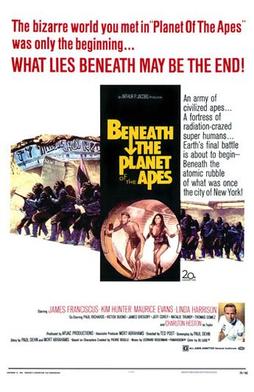
Beneath the Planet of the Apes is a 1970 American science fiction film directed by Ted Post from a screenplay by Paul Dehn, based on a story by Dehn and Mort Abrahams. The film is the sequel to Planet of the Apes (1968) and the second installment in the Planet of the Apes original film series. It stars James Franciscus, Kim Hunter, Maurice Evans, and Linda Harrison, and features Charlton Heston in a supporting role. In the film, another spacecraft arrives on the planet ruled by apes, carrying astronaut Brent (Franciscus), who searches for Taylor (Heston).

Life, the Universe and Everything is the third book in the six-volume Hitchhiker's Guide to the Galaxy science fiction "trilogy of five books" by British writer Douglas Adams. The title refers to the Answer to Life, the Universe, and Everything.

Ender's Shadow (1999) is a parallel science fiction novel by the American author Orson Scott Card, taking place at the same time as the novel Ender's Game and depicting some of the same events from the point of view of Bean, a supporting character in the original novel. It was originally to be titled Urchin, but it was retitled Ender's Shadow prior to release. Ender's Shadow was shortlisted for a Locus Award in 2000.

A doomsday device is a hypothetical construction — usually a weapon or weapons system — which could destroy all life on a planet, particularly Earth, or destroy the planet itself, bringing "doomsday", a term used for the end of planet Earth. Most hypothetical constructions rely on hydrogen bombs being made arbitrarily large, assuming there are no concerns about delivering them to a target or that they can be "salted" with materials designed to create long-lasting and hazardous fallout.
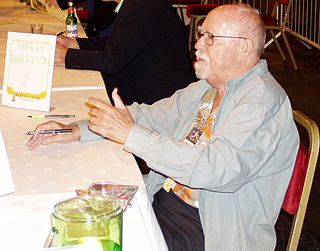
Harry Max Harrison was an American science fiction author, known mostly for his character The Stainless Steel Rat and for his novel Make Room! Make Room! (1966). The latter was the rough basis for the motion picture Soylent Green (1973). Long resident in both Ireland and the United Kingdom, Harrison was involved in the foundation of the Irish Science Fiction Association, and was, with Brian Aldiss, co-president of the Birmingham Science Fiction Group.

Bill, the Galactic Hero is a satirical science fiction novel by American writer Harry Harrison, first published in 1965. A novella length version appeared in the magazine Galaxy Science Fiction in 1964 under the name "The Starsloggers".
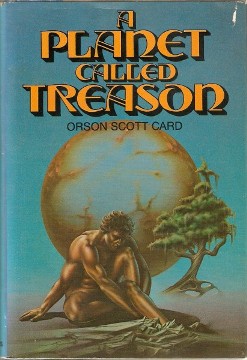
A Planet Called Treason (1979) is a science fiction novel by American writer Orson Scott Card about a radical regenerative named Lanik who is banished from his kingdom and travels to different regions of the planet, discovering the powers of the people living there. It was originally published by St Martin's Press and Dell Publishing Co. After being heavily revised, and growing roughly 50 pages longer, the book was republished under the title Treason (1988), also but only by St. Martin's Press.

Village of the Damned is a 1995 American science fiction-horror film directed by John Carpenter and starring Christopher Reeve, Linda Kozlowski, Kirstie Alley, Michael Paré, Mark Hamill, and Meredith Salenger. It is based on the 1957 novel The Midwich Cuckoos by John Wyndham, which was previously adapted into the 1960 film of the same name. The 1995 version is set in Northern California, whereas the book and original film are both set in the United Kingdom. The 1995 film was marketed with the tagline, "Beware the Children".
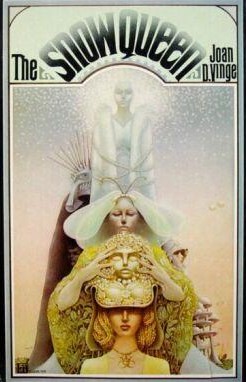
The Snow Queen is a 1980 science fiction novel by American writer Joan D. Vinge. It won the Hugo Award for Best Novel in 1981, and was also nominated for the Nebula Award for Best Novel in 1981.

Bomb the Bass is an electronic music alias of English musician and producer Timothy Simenon.
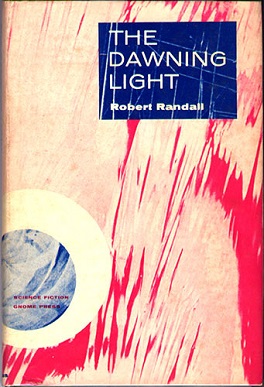
The Dawning Light is a 1959 science fiction novel published under the name Robert Randall, collaborative pseudonym of American writers Robert Silverberg and Randall Garrett. It depicts the changes, after the events of The Shrouded Planet by the same authors, in the society of the fictional planet Nidor, a world perpetually covered in dense cloud, inhabited by humanoids resembling humans but differing in several respects, notably in being covered from head to foot in short downy fur. The technological level of the society is about that of Renaissance Europe, and has been that way for thousands of years.

"The Marching Morons" is a science fiction story by American writer Cyril M. Kornbluth, originally published in Galaxy in April 1951. It was included in The Science Fiction Hall of Fame, Volume Two after being voted one of the best novellas up to 1965.

Timewyrm: Genesys is an original Doctor Who novel, published by Virgin Publishing in their New Adventures range of Doctor Who novels. It was the first book in that series, and was thought of by some fans as a continuation of the television series; in effect, a Season 27 to follow the televised Season 26.

Iceberg is an original novel written by David Banks and based on the long-running British science fiction television series Doctor Who. It was number 18 in the Virgin New Adventures range and featured the Cybermen, being a sequel to the serials The Invasion and The Tenth Planet. The events of the novel run concurrently with those of Birthright. Banks as an actor portrayed the Cyber Leader in several Doctor Who serials. A prelude to the novel, also penned by Banks, appeared in Doctor Who Magazine #204.

Return To Eden is a 1988 science fiction novel by American writer Harry Harrison.

Worldwar: In the Balance is a 1994 alternate history novel by American writer Harry Turtledove. It is the first novel of the Worldwar tetralogy, as well as the first installment in the extended Worldwar series that includes the Colonization trilogy and the novel Homeward Bound. The plot begins in late 1941, while the Earth is torn apart by World War II. An alien fleet arrives to conquer the planet, forcing the warring nations to make uneasy alliances against the invaders. Meanwhile, the aliens, who refer to themselves as the Race, discover that their enemy is far fiercer and more technologically advanced than expected.
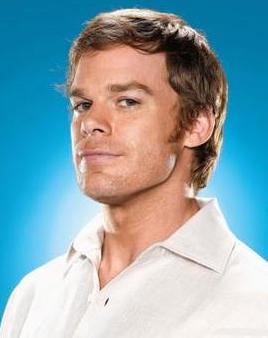
Dexter Morgan is a fictional character introduced as the antihero protagonist of the Dexter book series written by Jeff Lindsay, as well as the television series of the same name. In the television series, Dexter is portrayed by Michael C. Hall.
A salted bomb is a nuclear weapon designed to function as a radiological weapon, producing enhanced quantities of radioactive fallout, rendering a large area uninhabitable. The term is derived both from the means of their manufacture, which involves the incorporation of additional elements to a standard atomic weapon, and from the expression "to salt the earth", meaning to render an area uninhabitable for generations. The idea originated with Hungarian-American physicist Leo Szilard, in February 1950. His intent was not to propose that such a weapon be built, but to show that nuclear weapon technology would soon reach the point where it could end human life on Earth.